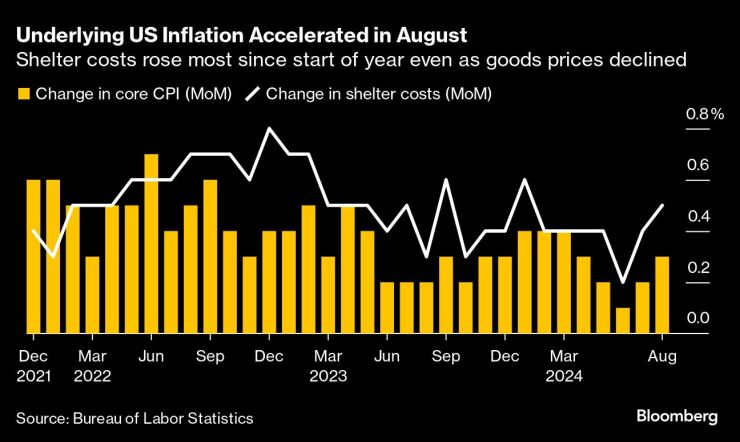Underlying U.S. inflation unexpectedly picked up in August on higher prices for housing and travel, undercutting the chances of an outsize Federal Reserve interest-rate cut next week.
The so-called core consumer price index — which excludes food and energy costs — increased 0.3% from July, the most in four months, and 3.2% from a year ago, Bureau of Labor Statistics figures showed Wednesday. The three-month annualized rate advanced 2.1%, picking up from 1.6% in July, according to Bloomberg calculations.
Economists see the core gauge as a better indicator of
The BLS said shelter was "the main factor" in the overall advance.
While Wednesday's reading won't deter the Fed from
Traders trimmed the probability that the Fed cuts rates by a half point next week to near zero. Treasury yields rose, the S&P 500 opened lower and the dollar pared its losses on the day.
READ MORE:
Though the figures are reported on a one decimal point basis by the BLS, Fed officials and economists often look further out for a better sense of the inflation trajectory. On a two-decimal basis, core CPI rose 0.28% from July.
In addition to shelter, the advance was boosted by airfares, apparel as well as daycare and preschool. Car insurance costs continued to rise, as did hotel stays.

Shelter prices, the largest category within services, climbed 0.5%, the most since the start of the year. That marked the second month of acceleration and defied widespread expectations for a downshift. Owners' equivalent rent — a subset of shelter and the biggest individual component of the CPI — rose at a similar pace.
Excluding housing and energy, service prices advanced 0.3%, the most since April, according to Bloomberg calculations. While central bankers have stressed the importance of looking at such a metric when assessing the nation's inflation trajectory, they compute it based on a separate index.
That measure — known as the personal consumption expenditures price index — doesn't put as much weight on shelter as the CPI does, partly why it's trending closer to the Fed's 2% target.
The PCE measure, which will be released later this month, draws from the CPI as well as certain categories within the producer price index. The PPI report, due Thursday, is projected to show a tame pace of wholesale inflation.
A sustained decline in the price of goods over most of the past year has largely been providing some relief to consumers. So-called core goods prices, which exclude food and energy commodities, fell 0.2%. The metric has now declined in 14 of the last 15 months.
Central bankers are increasingly paying attention to the labor side of their dual mandate amid emerging cracks in the job market. Hiring over the past three months is at the lowest since mid-2020, while job openings declined and layoffs rose in July. Anecdotally, employers have also indicated they're becoming more selective in hiring, with some cutting hours and leaving vacancies unfilled.
Fed officials also pay close attention to wage growth, as it can help inform expectations for consumer spending — the main engine of the economy. A separate report Wednesday that combines the inflation figures with recent wage data showed that real earnings grew 1.3% from a year ago, the most in over a year.






